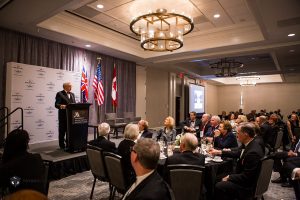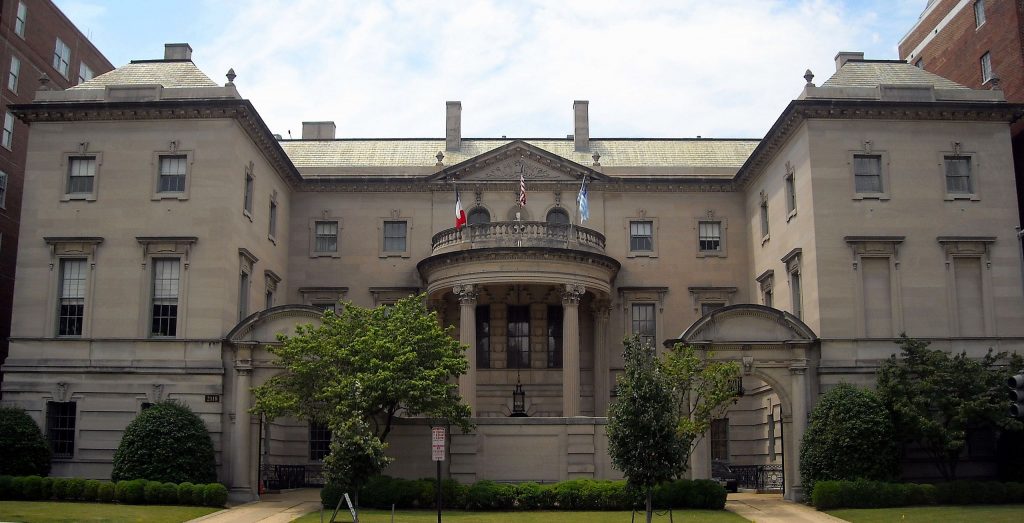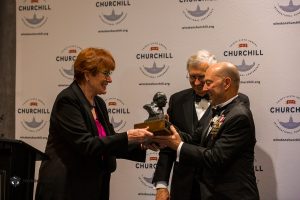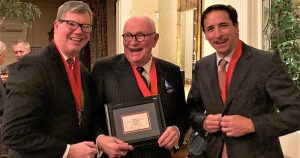
Bulletin #137 – Nov 2019
All the General’s Men

Anderson House, Washington—home to the Society of the Cincinnati
November 10, 2019
By GREGORY B. SMITH
The opening night reception of the 2019 International Churchill Conference took place on October 29 at Anderson House, the Headquarters of the Society of the Cincinnati. Society member Gregory B. Smith, who also leads the Northern California Chapter of the International Churchill Society, spoke about Winston Churchill’s induction into the oldest hereditary society in the United States.
Anderson House was originally the Washington home of Lars Anderson, a very wealthy Massachusetts man who devoted his life to public service, serving as an ambassador to several countries through several administrations. He was a member of the society and fortunately for us, although married, he had no heirs and left the society his mansion.
The society was founded in 1783 by Henry Knox, Baron Von Steuben, and other officers of Washington’s Continental Army in order to preserve the comradeship enjoyed by the officers and to promote charitable activity supporting families of fallen officers and officers who had fallen on hard times.
It was a hereditary society from the start with eligibility of membership offered to Continental Army officers who had served a minimum of three years and were honorably discharged. Eldest sons of fallen officers were also offered membership.

2024 International Churchill Conference
The society is organized as fourteen autonomous organizations, one for each of the thirteen original states and one for France. The rules for membership vary slightly between the organizations, but basically observe the rule that each member is the oldest male heir of the original member. In the 1860’s in the face of declining membership this was slightly modified so that the oldest male heir of a continental officer who was eligible to join, but did not, was now eligible for membership as well. Each member may designate a successor member.
There were some 6,000 officers in the Continental Army and a few hundred French officers, so that if they all were represented the society could have as many as about 13,000 members. Today the membership is between 3 and 4,000. Thus, the society is very different from most other hereditary societies where any number of descendants can claim membership.
After I joined, I named my son as my successor, and he has all the same rights and privileges of membership that I have save one: he cannot name his successor until I am gone.
The French society has somewhat different membership requirements. When King Louis XVI blessed the creation of the French society, membership was limited to those officers ranked at Lt. Colonel and above. The reason for this was that these positions were limited to members of the aristocracy. No matter what your military skills were, if you were not an aristocrat, you could not advance beyond Major. Still today our French membership roster contains many barons, marquis, ducs, and comptes. Our French members jealously preserve their titles even though they no longer have any official meaning.
The society was controversial from the start. Many prominent Americans, including Benjamin Franklin, thought it was an attempt to establish an American aristocracy. Washington, although elected the first President General and served till his death, shied away from involvement and never attended a meeting. He did observe his obligation to sign the membership diplomas of all the original members, some of which are treasured documents still handed down amongst some of our members.
The controversy led to several of the societies disbanding, starting with North Carolina in 1791, and the following year the French Society was shut down during the revolution. Admiral D’Estaing, the president of the French society was guillotined shortly afterwards. By 1824 all but six of the fourteen original societies had closed.
Following the US Centennial in 1876, interest in American history and genealogy blossomed, and many hereditary societies came into being. By 1904 all but the French society had reformed, but the French did reconstitute their organization in 1924.
So what does all this have to do with Winston Churchill?
During the Second World War, Churchill’s American ancestry was well publicized in the US including the point that he had descended from at least two revolutionary war officers.
It is not surprising, then, that in the glow of the Allied victory the Society of the Cincinnati sought out Churchill for membership. The invitation came in the form of a letter dated April 12, 1947 from Col. Bryce Metcalf, who was then both president of the Connecticut Society and president general:
Permit me to write to you of The Society of the Cincinnati, founded by General George Washington and his fellow officers of the Continental Army in 1783, an hereditary order that still flourishes….It is a source of great satisfaction to report to you that the Society holds you to be eligible to hereditary membership in the right of your ancestor, Lieutenant Reuben Murray of Burrall’s Regiment, such membership being in the Society in the State of Connecticut, where Lt. Murray received his commission….
Colonel Metcalf continued with details about membership and then closed with:
I should like to add that I am also President General of the entire Society and take especial pride in assuring you of the general gratification which will be felt throughout the order if you consent to be the first Englishman ever to be elected an hereditary member.
Churchill did indeed accept membership in the Connecticut Society in 1947, which made news around the country. It was not until almost five years later, however, that the opportunity arose for Churchill to meet with the society and receive its emblems of membership—the Eagle and the diploma.
By then Colonel Metcalf had died, and it fell to his successor Gen. Edgar Erskine Hume (who claimed to be the only US soldier to have been wounded in both World Wars as well as the Korean War) to invite Churchill to Anderson House when Churchill was in Washington to meet with President Truman in January 1952.
Churchill accepted the invitation, and the brief ceremony at Anderson House was preserved on film by Fox Movietone news. To watch the video, please CLICK HERE.
Churchill never attended a regular meeting of the society, but he did correspond with the leadership and submitted an autographed copy of his biography of his father to the Anderson House library.
Today, Churchill’s ancestor Lt. Reuben Murray is no longer regarded as a valid propositus, since he was in the militia and did not serve the minimum three years. But the other officer from whom Churchill was descended, Lebbeus Ball of Massachusetts is a valid claim. The Ball line of descent is currently represented by Duncan Sandys, Churchill’s great grandson.
Subscribe
WANT MORE?
Get the Churchill Bulletin delivered to your inbox once a month.




